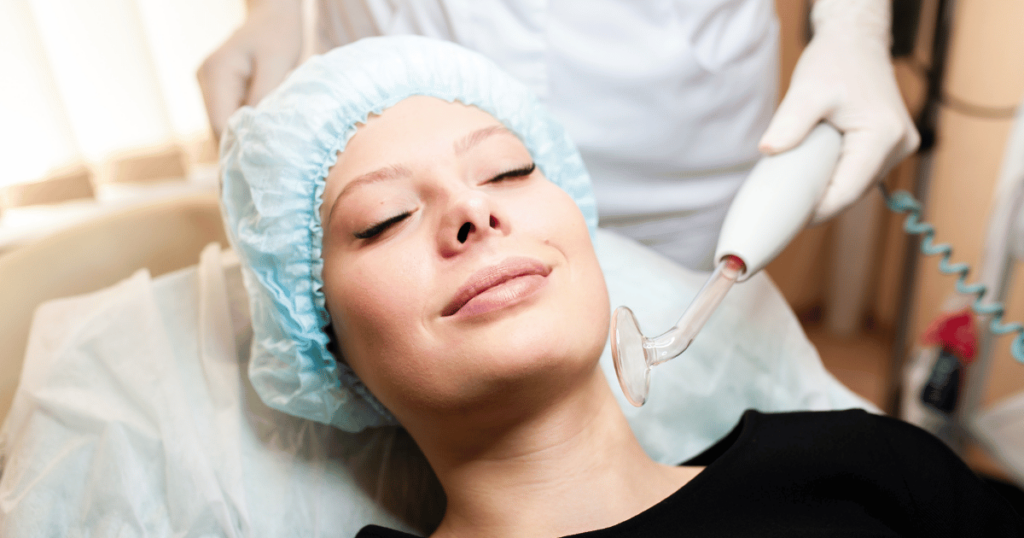Everyone, regardless of age, skin type, or lifestyle, yearns for a flawless skin tone.
This condition, characterized by irregular dark spots, age spots, or patches on the skin, is more than just a cosmetic concern. It can significantly impact a person’s self-esteem and confidence, affecting their daily interactions and overall quality of life.
But there’s good news for those grappling with this issue. A revolutionary technology, BroadBand Light (BBL) therapy, has emerged as a highly effective solution for correcting skin tone. This advanced form of light therapy harnesses the power of pulsed light to target and break down the unwanted melanin causing these dark spots, brown spots, and uneven skin tone.
In this post, we’ll delve into the transformative power of BBL for uneven pigmentation. We’ll explore how this innovative treatment works, its benefits, and how it can help you achieve the flawless, radiant skin you’ve always desired.
So, if you’re ready to say goodbye to uneven pigmentation and hello to a more youthful appearance, keep reading. Your journey to beautiful skin starts here.

Uneven Pigmentation: A Common Skin Problem
Uneven pigmentation is a prevalent skin issue that affects many people worldwide. It’s characterized by: irregular dark spots, age spots, or patches on the skin, which result from an overproduction of melanin.
Melanin is the pigment responsible for our skin colour, and when produced in excessive amounts, it can lead to an uneven skin tone. This condition can manifest in various forms, such as hyperpigmentation, sun spots, or dark spots, making the skin appear blotchy and uneven.
Causes of Uneven Pigmentation
There are several causes of uneven pigmentation, including:
- Sun Exposure: Prolonged and excessive sun exposure is one of the leading causes of uneven pigmentation. The sun’s UV rays can trigger an overproduction of melanin, leading to sun spots and other signs of sun damage.
- Hormonal Changes: Hormonal fluctuations, particularly during pregnancy or due to certain medications, can lead to melasma, a type of hyperpigmentation characterized by dark patches on the skin.
- Aging: As we age, our skin’s ability to regenerate new cells slows down, leading to an accumulation of damaged cells and pigmentation irregularities.
Skin Inflammation: Post-inflammatory hyperpigmentation can occur after a skin injury or inflammation, such as acne, leaving behind dark spots or patches.
The Impact of Uneven Pigmentation on the Skin
Uneven pigmentation can have several effects on the skin, each impacting different aspects of a person’s life and well-being. Here’s a closer look at these impacts:
- Aesthetic Impact: Dark spots, age spots, and an overall uneven skin tone can affect the skin’s appearance, making it look aged and dull. This can lead to a less youthful appearance and a rough skin texture, which are often associated with premature skin aging.
- Skin Health: Overproduction of melanin can lead to an accumulation of damaged skin cells, potentially leading to more serious skin conditions over time. These conditions can range from hyper-pigmentation and sun damage to more severe skin disorders. It’s crucial to address these issues early with effective treatments like BroadBand Light therapy to promote healthy skin and prevent further damage.
- Psychological Impact: Uneven pigmentation can significantly impact a person’s self-esteem and confidence. This can affect their social interactions and overall quality of life. The psychological impact can be as profound as the physical one, making it even more important to seek effective treatment options.
By understanding the various impacts of uneven pigmentation, it becomes clear why treatments like BBL for uneven pigmentation are so important. They not only improve the skin’s appearance but also contribute to better skin health and improved psychological well-being.
BroadBand Light (BBL) Therapy: A Solution to Uneven Skin Tone
In the realm of cosmetic dermatology, BroadBand Light (BBL) therapy stands out as a groundbreaking technology designed to address a variety of skin concerns, including uneven skin tone. This advanced form of light therapy utilizes high-intensity light energy, which penetrates the skin’s layers to target and break down the unwanted melanin causing dark spots and uneven pigmentation.
BBL therapy operates on the principle of photothermal energy. This involves the use of light energy to generate heat, which then targets the melanin in the skin. Here’s how it works:
- Light Energy: The BBL device emits pulses of light that penetrate the skin to reach the melanin.
- Targeting Melanin: The light energy is absorbed by the melanin, causing it to heat up.
- Breaking Down Melanin: The heat breaks down the melanin, which is then naturally eliminated by the body’s lymphatic system.
- Stimulating Skin Cells: The process also stimulates the skin cells to produce new collagen, improving the appearance of uneven skin texture and tone.
Correcting Skin Tone with Broadband Light Therapy
Correcting skin tone with broadband light therapy is not a one-size-fits-all procedure. One of the key benefits of BBL treatment is its ability to be customized to suit different skin types and conditions.
The procedure is non-invasive, meaning it doesn’t involve any incisions or injections. This makes it a safe and effective solution for those seeking to correct their skin tone without the risks and downtime associated with more aggressive laser procedures or invasive surgeries.
The use of broadband light technology is a journey that involves several key steps. Each stage is crucial in ensuring the effectiveness of the treatment and the satisfaction of the patient. Here’s a closer look at the process:
Initial Consultation: Understanding Your Skin’s Needs
The initial consultation with our staff is the first step in the journey to correcting skin tone with broadband light therapy. Here’s what happens during this crucial stage:
- One of our educated Medical Intake Coordinators will conduct a thorough assessment of the patient’s skin condition using advanced skin analysis technology. This includes:
- Identifying specific skin concerns, such as sun spots, age spots, or other signs of uneven pigmentation.
- Evaluating the overall health and condition of the skin.
- The nurse engages in a detailed discussion with the patient to understand their specific concerns and goals. This involves:
- Gaining insight into the patient’s expectations from the BBL treatment.
- Determining the most suitable treatment plan based on the patient’s skin condition and desired results.
- The consultation also provides an opportunity for the patient to ask any questions they may have about the BBL treatment. This could include inquiries about the procedure itself, potential side effects, recovery time, and expected results.
This initial consultation is crucial in ensuring that the treatment plan is tailored to the patient’s unique skin needs and goals, setting the stage for a successful BBL treatment journey.
Customized Treatment Plan: Tailoring the BBL Treatment to Your Skin
Following the initial consultation, a personalized BBL treatment plan is designed to address the patient’s unique skin needs. Here’s what this entails:
- The treatment plan is developed based on various factors, including:
- The patient’s skin type: This determines the intensity of the light energy to be used during the procedure.
- The severity of the patient’s pigmentation issues: This helps in deciding the number of BBL sessions required.
- The patient’s desired results: This guides the overall approach and goals of the treatment.
- The customized treatment plan outlines several key details, such as:
- The number of BBL sessions required: This depends on the severity of the pigmentation issues and the patient’s desired results.
- The intensity of the light energy to be used: This is determined by the patient’s skin type and the extent of their pigmentation issues.
- The specific areas to be targeted during the procedure: This is based on the location of the pigmentation issues on the patient’s skin.
Aside from uneven skin pigmentation, BBL is also used to address facial veins, liver spots, cherry angiomas, acne scarring, and other visible signs of aging. This is why a tailored approach is needed, as it ensures that each patient receives the most effective treatment for their specific skin concerns, paving the way for optimal results from the BBL therapy.
The BBL Procedure: Transforming Your Skin with Light Energy
The laser treatment procedure is a key stage in the journey to correcting skin tone with broadband light therapy. Here’s a step-by-step breakdown of what happens during this process:
- The patient’s skin is treated with high-intensity light energy using the BBL device. This involves:
- Delivering the light energy in rapid pulses: This allows the energy to effectively penetrate the different layers of skin.
- Targeting areas of uneven pigmentation: The light energy is directed towards the dark spots or patches on the skin.
- The light energy interacts with the melanin in the dark spots in the following ways:
- Absorption: The melanin absorbs the light energy, causing it to heat up.
- Breakdown: The heat causes the melanin to break down, which is then naturally eliminated by the body.
- The procedure typically lasts about 20-30 minutes, depending on the size of the area being treated.
- Despite the high-powered energy used, the procedure is generally comfortable, with a topical anesthetic or numbing cream applied. Patients often compare the sensation to the snap of a rubber band against the skin, but any temporary discomfort is well worth it.
This procedure is a crucial part of the BBL treatment, as it directly targets the melanin causing uneven pigmentation, paving the way for a more even and radiant skin tone.
Post-Treatment Care: Ensuring Optimal Results and Healthy Skin Recovery
After the BBL procedure, patients are guided through a series of aftercare instructions to ensure optimal results and a healthy skin recovery. Here’s what this involves:
- Sun Protection: Patients are advised to:
- Avoid direct sun exposure for at least a week after the procedure. This helps to prevent any further sun damage and allows the skin to heal effectively.
- Use a high-SPF sunscreen. This provides additional protection against harmful UV rays, especially in the days following the treatment.
- Skin Care
- Patients are recommended to apply specific skin care products through a skincare regimen. These products are designed to soothe and nourish the skin, promoting a healthy recovery. They may include creams or serums with active ingredients that support skin healing and rejuvenation.
- Activity Restrictions
- Patients may also be advised to avoid certain activities. This includes strenuous exercise or hot baths, which could potentially irritate the skin in the days following the treatment.
Following these aftercare instructions is crucial in maintaining the results of the BBL treatment and promoting a healthy, radiant complexion. It’s part of the commitment to ensuring that each patient enjoys the full benefits of BBL therapy.
Patient Outro
In conclusion, BBL face for uneven pigmentation offers a promising solution for those struggling with uneven skin tone and hyperpigmentation.
By harnessing the power of broadband light therapy, it’s possible to correct skin tone, fade brown spots, and reveal a more youthful and radiant complexion.
The process is non-invasive, safe, and customizable to individual skin needs. It not only targets and breaks down unwanted melanin but also stimulates the skin’s natural healing process, promoting collagen production and new skin cells. This results in healthier, more radiant skin with a smoother texture and more even tone.
Remember, every individual’s skin is unique, and results can vary from patient to patient. It’s always best to consult with a professional dermatologist to discuss your specific skin concerns and goals.
Don’t let uneven pigmentation hold you back. Discover the transformative power of BBL therapy and step into a world of flawless, natural beauty. Book your free consultation today and embark on your journey to beautiful skin.
















